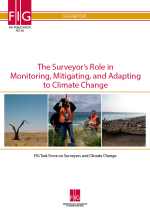

FIG PUBLICATION NO. 65The Surveyor’s Role in Monitoring, Mitigating, and Adapting to Climate ChangeFIG Task Force on Surveyors and Climate Change
|
 |
|
|
 |
This publication as a .pdf-file (72 pages - 3.3 MB) |
This publication is the result of extensive debates, discussions, and
presentations by the FIG Task Force on Surveyors and Climate Change over the
past three years. The Task Force was established at FIG’s Working Week in
Marrakech, Morocco, in May 2011, to facilitate the work of the international
surveying community in deliberating and better understanding how the
surveying profession could contribute and assist the global community in
measuring and monitoring climate change with its sciences, technologies,
professional knowledge, and practices. The Task Force was chaired by
Emeritus Professor John Hannah, New Zealand Institute of Surveyors and
University of Otago. Its
members, with their diverse backgrounds, experiences and expertise, were
drawn from the global community of professional surveyors.
While individual surveyors have had a substantial involvement in climate change studies for almost three decades, it wasn’t until 2002 that climate change issues became a formal part of the deliberations within the International Federation of Surveyors (FIG). The initial emphasis was on climate change and sustainable development – an emphasis that lead to a number of FIG publications and declarations. These were then followed by a series of initiatives that were substantially focused on how the coastal and marine environment should be managed in the light of likely future climate change. In 2008, an FIG working group was formed to investigate spatial planning in coastal regions. This working group, in producing its report in 2010, noted that from a surveyor’s perspective climate change issues were not restricted to the coastal zone alone, but rather were diverse and cut across many other dimensions of the surveyors’ professional activities.
The FIG Task Force on Surveyors and Climate Change set out both to explore and report on where and how surveyors could assist the global community in measuring and monitoring climate change, and also to elaborate on the part that they could play in adapting to climate change and helping to mitigate its impacts. This publication provides a detailed summary of how the professional skills of the surveyor can be leveraged to help the global community as it grapples with the climate change issue. In reading the document it becomes clear that in many regards surveyors are not only the custodians of enabling technologies that are critically important to understanding climate change impacts, but that by virtue of their multi-disciplinary skills, they provide the bridge across the divide that can often exist between those who work in the natural sciences versus those working in the social sciences. It is thus a document that covers a broad spectrum of thoughts and practice, bringing about the convergence of the spatial and societal aspects of climate change.
The efforts of the Task Force are to be applauded and appreciated. We acknowledge the efforts and contributions of the authors in providing such a comprehensive document. It is our hope that it will not only spur surveyors on to a greater contribution to climate change studies, but that it will also alert global agencies as to the knowledge and resources that the surveying profession can bring to the table as climate change policy responses are developed.
CheeHai Teo, FIG President (2011–2014)
John Hannah, Chair, FIG Task Force on Surveyors and Climate Change
The surveyor is a practical, pragmatic, people-centric professional person,
skilled in spatial measurement, able to represent, interpret and analyse spatial
information, highly knowledgeable in the administration and governance of rights
to the land and sea, and capable of planning for the development and use of land
resources. It is this unique combination of skills that allows the surveyor to
not only collect and analyse data vital to understanding the impacts of climate
change, but also to grasp many of the complex human, political and physical
interactions that arise in dealing with climate
change issues.
Understanding the full extent of the complex interactions that are part of
climate change science requires not just ad hoc monitoring of the earth, but
rather integrated earth measurement and monitoring systems, many of which are
satellite based. These data include radar altimetry, gravity, light detection
and ranging (LiDAR), as well as sensors that use reflected or back-scattered
sunlight as their radiation source. Such data can be used not only to provide
detailed information about the terrain, land use patterns, water storage,
ice mass balance and a host of other useful inputs which, when used together,
provide a detailed picture of earth system change, but also to assist with
emergency response and recovery operations after natural disasters. However, in
order for this data to be correctly interpreted and integrated, it is essential
that it not only be time tagged but also given well defined coordinates in a
known reference system. Surveyors not only help define these coordinates and the
reference systems that produce them but also help design and use the software
tools that support the subsequent analyses of the resulting spatial data.
Some years ago the surveying profession recognised that its blend of
professional skills offered a unique platform from which it could help the
global community as it grappled with both climate change and a wider group of
environmental issues. In 2011, following a series of earlier reports, the FIG
formally established a Climate Change Task Force. This publication, which
reflects the primary output from the task force, gives a detailed and
comprehensive analysis of the many ways that surveyors can partner with global
and regional organisations, and States, in confronting and responding to the
climate change challenge.
Climate change presents challenges across a broad spectrum of human activities. In this regard, the surveyor’s skills have particular application in the following areas.
As humanity seeks to respond to the climate change challenge, and as it considers this broad spectrum of sectors where the surveyor’s core skills can be leveraged, several common themes emerge.
Land administration systems. There is an urgent need for cadastral, land tenure, and land administration systems that fully reflect property rights and give tenure security to all legitimate landholder. In the first instance, these systems need to be accessible and able to be integrated with other land use and climate risk data so that climate change mitigation and adaptation strategies can encompass the spatial extent and rights of land owners and land occupiers. In addition, ‘unbundled’ property rights also need to be considered so that carbon credit titles, for example, can be registered and separated in land administration systems. Such developments as these are crucial if the climate related land use changes that will inevitably occur are to work to the benefit of the human race. Surveyors are not only developing “fit-for-purpose” approaches that are aimed at all tenures along a continuum of land rights, but they are also developing formal land administration systems to help with the demarcation of boundaries, cadastral and participatory mapping of social tenures, and with the recording of rights.
Spatial monitoring and measuring. Precise spatial measurement, which is the most traditional and best known skill of the surveyor, assists not only in monitoring the impacts of climate change but is also an essential element in adaptation strategies. For example, sea level change analyses require the precise spatial monitoring of tide gauges, using both conventional levelling techniques and GPS positioning. Land use decisions and erosion control are typically based upon detailed topographic mapping that may come from conventional land surveying techniques, or from laser scanning, or from digital image analysis. Precision agriculture (an important technique for increasing crop yields) relies upon GPS measurement technology. The construction of the new engineering infrastructure needed to support climate change adaptation requires the use of levelling, total station, and GPS technologies.
Spatial information management. The development of digital land related databases not only involves the comprehensive collection of relevant data, but also its integration into a common coordinate framework. This integration then needs to extend to the integration of social, economic, environmental and geographical factors so as to allow data mining, interpretation, and visualisation of different climate change mitigation and adaptation strategies. These design and integration functions can be undertaken by the surveyor.
Adaptation and disaster risk management. A range of adaptation strategies can be embedded into a land administration system so as to control the occupation and use of land and protect the vulnerable. Furthermore, disaster risk management and climate change proofing are core adaptation strategies for the urban environment. The identification of land suitable for the resettlement of climate refugees, the provision of secure land rights, and then the development of the necessary infrastructure are all essential tasks that can be undertaken by a surveyor.
Land-use planning. Long term spatial planning is an essential part of greenhouse gas emissions reductions. In areas with high levels of land administration capacity (typically the developed world), energy conservation is being achieved through improved design processes. In areas with low levels of land administration capacity, poor records, limited enforcement of land use policies, and poorly regulated land markets, the challenge is to find innovative ways for undertaking necessary land use planning.
It is clear that in many regards, surveyors are the custodians of enabling
technologies and systems that are critically important to the future of the
human race. Surveyors provide relevant geographic information for early warning
and climate-related mapping, secure land and natural resource tenure systems to
reduce vulnerability to disasters, and systems for managing urban growth and the
use of land. In this way the surveyor’s work supports climate change adaptation
and mitigation, as well as social justice, economic growth, and environmental
sustainability. However, surveyors recognise that the depth and breadth of the
issues involved in climate change studies (whether scientific, social,
political, or environmental), are of sufficient complexity that
interdisciplinary cooperation is an essential prerequisite to finding robust
solutions. Furthermore, partnerships at local, regional, national and
international levels are essential if integrated, whole of community solutions
are to be found. Surveyors, as land professionals, are committed to partnering
with communities, professional groups,
government agencies and global agencies in order to deliver these solutions.
Editor: John Hannah
Contributing Authors: Isaac Boateng, Sagi Dalyot, Stig Enemark, Frank
Friesecke, John Hannah, David Mitchell, Paul van der Molen, Merrin Pearse,
Michael Sutherland, and Martinus Vranken
Read the full FIG Publication 65 in pdf
Copyright © The International Federation of Surveyors
(FIG) 2014., September2014
All rights reserved
International Federation of Surveyors (FIG)
Kalvebod Brygge 31–33
DK-1780 Copenhagen V
DENMARK
Tel. + 45 38 86 10 81
E-mail: FIG@FIG.net
www.fig.net
Published in English
Copenhagen, Denmark
ISSN 1018-6530 (printed)
ISSN 2311-8423 (pdf)
ISBN 978-87-92853-26-4 (printed)
ISBN 978-87-92853-27-1 (pdf)
Published by
International Federation of Surveyors (FIG)
Front cover photos: left and right ©Paul van der Molen,
middle: ©School of Surveying, University of Otago
Back cover photo: ©School of Surveying, University of Otago
Design: International Federation of Surveyors, FIG and Lagarto
The Surveyor’s Role in Monitoring, Mitigating, and Adapting to Climate Change
FIG Task Force on Surveyors and Climate Change September 2014
Published in English
Published by The International Federation of Surveyors (FIG), September 2014
Copenhagen, Denmark
ISSN 1018-6530 (printed)
ISSN 2311-8423 (pdf)
ISBN 978-87-92853-26-4 (printed)
ISBN 978-87-92853-27-1 (pdf)